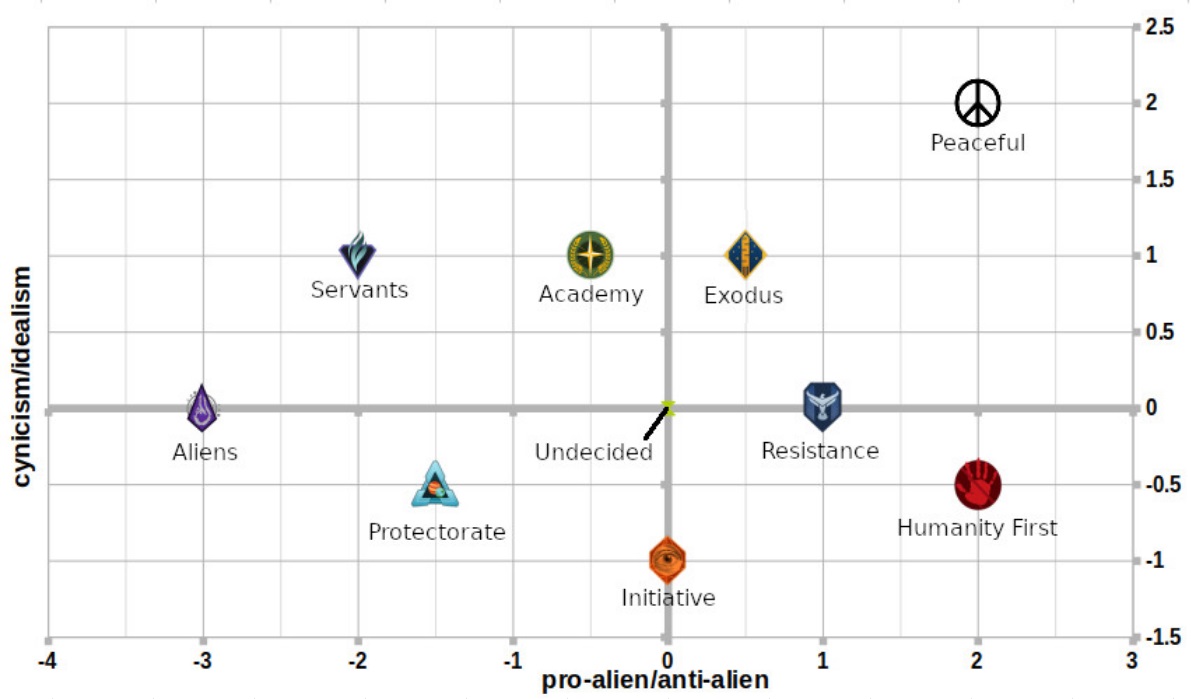Public Opinion: Difference between revisions
(Add actual values of ideologies) |
m (Add navbox) |
||
| Line 82: | Line 82: | ||
Ideology distance is calculated by normal means; [https://en.wikipedia.org/wiki/Euclidean_distance good old pythagoras]. | Ideology distance is calculated by normal means; [https://en.wikipedia.org/wiki/Euclidean_distance good old pythagoras]. | ||
{{Mechanics_Navbox}} | |||
Revision as of 20:31, 5 November 2022
(The content of this page is based on Terra Invicta Dev Diary #7: Public Opinion.)
Public Opinion regarding the aliens is an important factor in Terra Invicta.
With news of the alien arrival reaching every corner of the globe, the people of Earth’s nations form a range of opinions on whether this monumental event constitutes a boon or a threat to humanity. These views are malleable to a degree that depends on conditions in the nation and the level of effort spent to influence them.
In gameplay terms, global public opinion favorable to your faction is a major source of your Influence income, and it also provides bonuses to your councilor missions in nations where the people agree with you. You can influence public opinion in a nation via the Propaganda mission and through the Unity priority, or globally through completing projects, which are part of the research system that will be explained in a future post.
Public opinion corresponds to the ideologies of the seven human factions – Resist (The Resistance), Destroy (Humanity First), Escape (Project Exodus), Cooperate (The Academy), Appease (The Protectorate), Submit (The Servants), and Exploit (The Initiative). (People who support the “Exploit” ideology of The Initiative are either opportunists like the faction’s leadership, or else they have false beliefs about the aliens – like the aliens are a hoax – that serve The Initiative’s ends.) An eighth ideology, “Undecided,” is a middle ground for people on the fence. There is no "Undecided" faction, however.
Public opinion is a national-level variable, so each nation will break down into a set of percentages describing support for each ideology. The diversity of public opinion can also influence a nation’s cohesion stat.
Initial public opinion is set with some controlled randomness based on democracy, education, and cohesion in a nation. Democracy is in there because authoritarian governments tend to control information access by its citizens, so public opinion will be less diverse in those states as the people receive the government’s line on the aliens. Initial public opinion will tend to favor the “cooperate” or undecided ideologies.
Mechanically, we’ve mapped the range of public opinion onto an x-y grid that looks like this:
The x axis corresponds to the degree of support or opposition to the aliens. The y axis represents idealism versus cynicism about humanity and its response to their arrival. The aliens themselves are included because they can take actions that influence public opinion about them.
When events that may shift public opinion are processed, it creates something like a gravity well at the coordinates of a particular ideology, pulling things toward it. A nation’s population is subdivided by its existing beliefs, and groups within that population all roll a die to see if they will change their opinion and if so, by how much. New ideology coordinates are calculated for each population group that is changing its opinion, and those are mapped to one of the existing ideologies.
This serves to track opinion gradually shifting over time – heavy Humanity First propaganda highlighting alien atrocities may pull views to the right side of the map – someone supporting The Resistance may decide the aliens and their supporters need to be entirely wiped out and turn to back Humanity First, while a supporter of The Academy may begin to have doubts and fall into the undecided category.
Certain events – like atrocities committed by your faction – can also function as “negative propaganda” – driving supporters away from a particular ideology, and pushing fence-sitters into a more extreme camp.
Ideology distance
The factions are mapped on a 2d-map:
| Faction | Xenophobia | Idealism |
|---|---|---|
| Resistance | 1 | 0 |
| Humanity First | 2 | -0.5 |
| Initiative | 0 | -1 |
| Servants | -2 | 1 |
| Protectorate | -2 | -0.5 |
| Academy | -0.5 | 1 |
| Exodus | 1.5 | 1 |
| Aliens | -3 | 0 |
| Undecided | 0 | 0 |
| Peaceful | 2 | 2 |
When the game calculates the distance between ideologies, it uses these values. There's technically a third axis, but it's zero for every ideology.
When the game assigns an ideology to the public or the elite, it does so by averaging public support and control points, respectively. For instance, a country with 2 control points owned by the resistance and 1 by the servants, the elites would be at ((2*1 - 2)/3, 2*0 + 1) = (0, 1). This puts them closest to the Academy, so that's how they're viewed for the purposes of the game - they are thus saved at (-0.5, 1) and not (0, 1).
For public opinion, the game does the same thing - but with percentage of support instead of discrete control points. 67% resistance, 33% servants would be equivalent to the example above, but it's more continuous.
Ideology distance is calculated by normal means; good old pythagoras.
| Terra Invicta mechanics | |
|---|---|
| Factions | |
| Council | |
| Earth | |
| Space | |
| Modding | Mod tools • Console Commands |
 Hooded Horse Wikis
Hooded Horse Wikis
